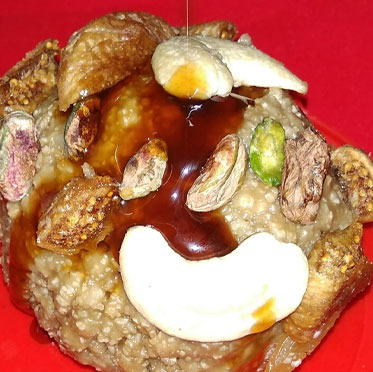





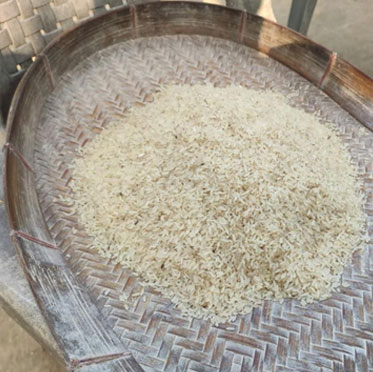
Tulaipanji Rice
Tulaipanji rice is non-basmati aromatic rice with GI status. It is being produced mostly in the Uttar Dinjapur district. There are only some scattered pockets in the Dakshin Dinajpur district which do cultivation of Tulaipanji rice. Mohiniganj area of North Dinajpur is famous for Tulaipanji rice.
The first modern mention of Tulaipanji rice is found in the district Gazetteer of Dinjapur written by Francis Buchanan Hamilton in the year 1833. There are some old Bengali literatures which mentions the use of Tulaipanji rice for serving guests during social occasions. It was also used for moments like making Pyasam (Kheer) for guests during home arrivals. This rice has been in existence for more than 1000 years and has been preserved by the cultivators of Dinjapur area and particularly in Present day North Dinjapur district.
The farmers producing the Tulaipanji rice in this district get good price for their product. The online selling of this branded rice has also increased their income level. However the scale of production of Tulaipanji rice in South Dinjapur district is too low and too scattered to gain any substantial benefit. An effort in increasing the cultivation area of Tulaipanji rice in district and then forming a Farmer Producer organization can help a lot in this direction. View Vendor List...

Wooden Mask or Mukha of Kushmandi
The Wooden Mask or Mukha of Kushmandi is an important part of theatre craft of Dakshin Dinajpur district in the state of West Bengal.
The masks are usually adorned by the Rajbanshis community during the monsoons, especially during the cultivation season. This is an ethnic group found in North Bengal and nearby areas. Rajbanshi means royal community and they have their own specific cultural practices. There is a ritualistic dance form called Gomira dance which is done in adoration of the Gods to usher good fortune and drive out evil forces.
There is another type of Mask that is used in household for the decoration purpose. The two types of masks are made by the same process and materials, with some difference between them. If the mask is to be used for the purpose of dancing, only then the eyes, mouth, etc are hollowed out. The masks that are crafted for decoration purposes are also bulkier and heavier than the mask used in Gomira dance. Recently the artists are making diversified products in the form of small fridge magnets, lamp shades etc.
Kushmandi’s Wooden Mask got the GI status through the application made by Mahisbathan Hastashilpa Samabay Samiti Limited in 2018. Approximately, one thousand artisans are involved in carving of wooden mask. View Vendor List...
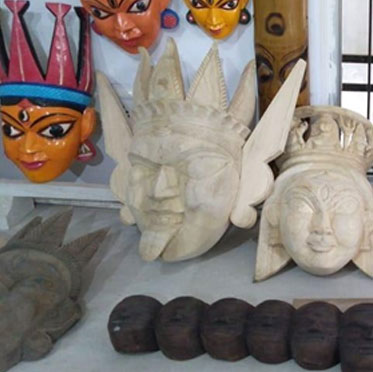

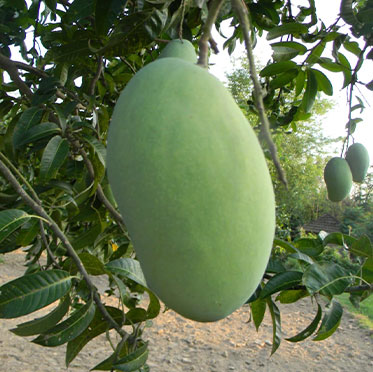
Malda Fazli Mango
These mangoes are grown in all 15 blocks of Malda district. This variety is relatively larger than the other mangoes and has lots of pulp. A single mango can weigh up to 1 kg. This variety is used in making pickles and jams. These mangoes weigh between 600-1000gms.
The thickness of their skin is medium and has yellowish green colour. The colour of the flesh is light orange when it is ripe to its fullest.
The TSS of this variety is 15. It is a late variety. This variety is grown in the blocks of Chanchal–I, Chanchal–II, Ratua–I, Ratua–II Harishchandrapur–I Harishchandrapur–II English Bazar Gazole Habibpur Kaliachak–I Kaliachak–II Kaliachak–III Manickchak Old Malda Bamangola.

Malda Lakshman bhog Mango
These mangoes are grown in all 15 blocks of Malda district. It is also called Lakhanbhog and weigh between 200-300gms. The thickness of their skin is thin and has yellowish orange colour. The colour of the flesh is medium orange when it is ripe to its fullest. The TSS of this variety is 16. This variety is grown in the blocks of Chanchal–I, Chanchal–II, Ratua–I, Ratua–II Harishchandrapur–I Harishchandrapur–II English Bazar Gazole Habibpur Kaliachak–I Kaliachak–II Kaliachak–III Manickchak Old Malda Bamangola. View Vendor List...
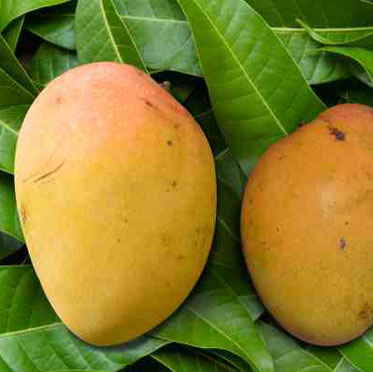

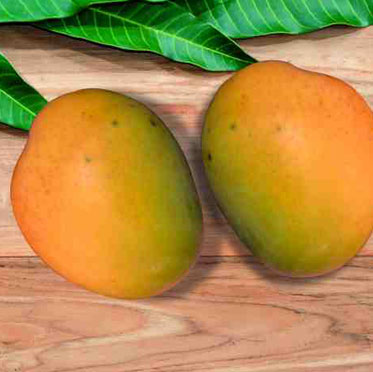
Malda Himsagar Mango
Himsagar is regarded as the king of mangoes. These mangoes are grown in all 15 blocks of Malda district. It is also known as Khirsapati. These mangoes weigh between 200-300 gms. The thickness of their skin is medium and has yellowish orange colour. The colour of the flesh is dark orange when it is ripe to its fullest.
The TSS of this variety is 25. The pulp content is around 77%. Devoid of fibre, the pulpy fruit has inspired several poets to pen down poetry and dedicate songs to it too.
The fruit is known to be ripe and rich for consumption only in the second week of May, till the end of June. This variety is grown in the blocks of Chanchal–I, Chanchal–II, Ratua–I, Ratua–II, Harishchandrapur–I, Harishchandrapur–II, English Bazar Gazole Habibpur Kaliachak–I, Kaliachak–II, Kaliachak–III, Manickchak Old Malda Bamangola. View Vendor List...

Gobindobhog Rice
Gobindobhog rice, locally called Khas Dhan, is one indigenous variety of rice that is produced locally. It has a distinct aroma and is white non-Basmati type, buttery, short- grain rice. It got its name as it constitutes and essential ingredient of the offerings made to lord Govinda.
The milled rice of ‘Gobindobhog’ contains low-intermediate (17.9%) amylose, 7.2% protein, elongation ratio and medium-strong (2.56) aroma. It got Gi registered in 2017. View Vendor List...
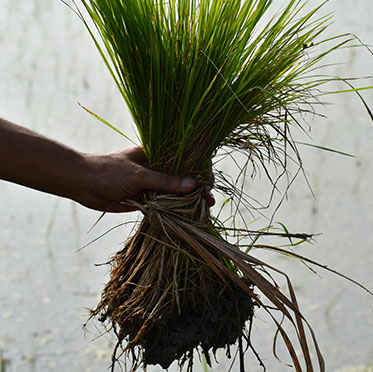

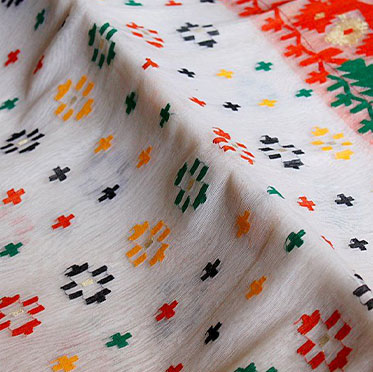
SANTIPURI SAREE
Santipur Saree is produced mainly at Santipur Municipality (Nadia) and its adjacent areas located at Nadia district. Having a recorded history from around 500 years, shantipur sarees are world famous and are woven across a variety of fabric like silk, tussar, cotton, mulmul etc. in roughly 1,25,000 handloom centers. Many varieties like Tangail, Shantipuri, and Jamdani saree are woven by the skilled artists. It got GI registered in 2009. View Vendor List...

MADHUR KATHI MATS
Paschim Medinipur district has a tradition of mat weaving known as Madhur Kathi. Mathur Kathi mats absorb sweat and do not emit heat, making them appropriate to the humid climate of the region.
There are three types of Madhur Kathi mats - ekhrokha, do rokha, and masland mats. EkhRokha are the simplest, light and thin mats while do rokha or double mats are thicker mats. Masland is of a higher quality having distinctive patterns, requires more than two people to weave it, and hence has the highest price amongst the three.
Madhur kathiinvolves weaving reed from madhurKottir (a sedge ofplant named Cyperus) and deriving maroon/red colours from seeds of Achiote tree (also known as Rang Gach in Paschim Medinipur), black dyes from Haritaki fruit and other colours from vegetable dyes. The dyed mats are then dried in sun before being used for weaving. Madhur Kathi was granted GI tag by Indian Patent Office in March 2018.
View Vendor List...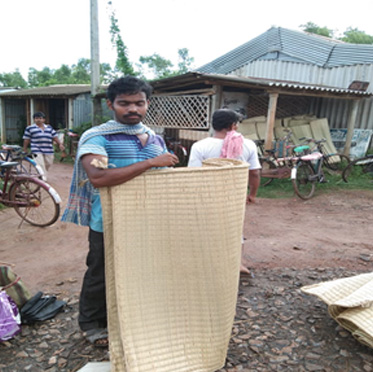

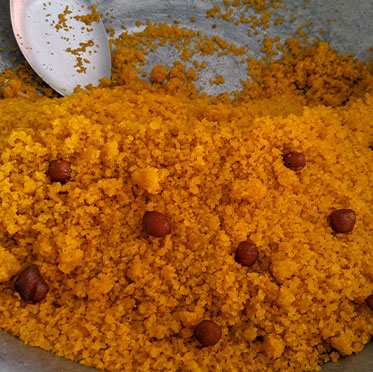
Mihidana
Word Mihidana is derived from two words, mihi – fine and dana – grain, meaning ‘fine grain’. This sweet dish is prepared by using ingredients such as Gobindobhog rice, Kaminibhog rice, sugar, saffron, gram flour, ghee. The Gobindobhog rice is short grain, aromatic, sticky rice with a buttery taste and is traditionally used in offerings to the family deity of the Setts of Kolkata- Govindajiu.
The human skill to prepare Mihidana has been acquired through generations. Mihidana got registered as GI on March 13, 2015 under Geographical indication number 526, falling in the class – 30 – in food stuff. View Vendor List...

Sitabhog
Sitabhog, a sweet dish resembling rice or seviaan, is made up of ingredients namely cottage cheese (Chhana), gram flour or besan, Gobindobhog rice flour, sugar, bay leaves, cloves, ghee. It looks as if white rice is served with small pieces of Gulab Jamuns. These small Gulab Jamuns are made up of flour, milk powder and Ghee and are known as Nikhuti.
A special starch has been developed by scientists that increase its shelf life. As such, the shelf life of Sitabhog is just one day and therefore, transporting it to other parts of India becomes difficult without proper packaging. Sitabhog was registered on March 13, 2015 under Geographical indication number 525. View Vendor List...


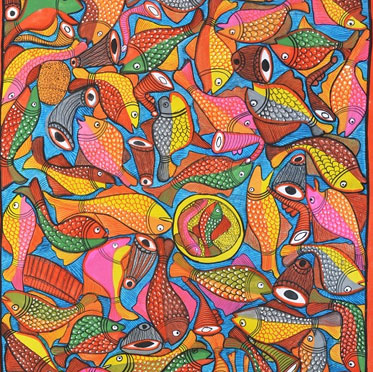
Bengal Patachitra
Bengal Patachitra is a traditional, cloth-based scroll painting mainly practiced by Painters called Chitrakars or Patuas in Naya village in the Pingla block of West Medinipur district of West Bengal.
The word ‘Pata’ comes from the Sanskrit word ‘Patta’, meaning cloth and ‘Chitra’ refers to painting. In Patachitra, stories are painted as frames on long scrolls and the Patuas who paint Patas, gradually unfurl them while presenting the story through their songs.
One of the fascinating aspects of Patachitra is the use of natural colours derived from local sources like fruits and flowers. The Patuas paint and sing on various themes like mythological tales (Ramayana, Mahabharata, Mangalkabya), historical and contemporary themes (biographies of great personalities, nuclear warfare) and social issues (women empowerment, child right, health, literacy). View Vendor List...

Joynagar Moa
Joynagar Moa is one of those few Bengali delicacies of Bengal that have managed to keep it original form and texture intact even today. It is a famous mouth-watering seasonal sweet delicacy of West Bengal produced mainly during winter. It is prepared from Kanakchur Khoi an aromatic rice and gur (date palm jaggery) and gawa ghee (a type of clarified butter made from cow's milk), cardamom, cashew, rasins and posto (poppy seed).
This gur which is unique in its place of origin Joynagar. This gur is the core and binder of popped rice and other condiments which constitute the round shaped Joynagar Moa. The flavour and sweetness of this gur make this genre of Moa - a popular and lovable combination of taste and aroma with a long tradition.
This variety of Moa originated in Joynagar city of South 24 Parganas district in the Indian State of West Bengal. Joynagar Moa Nirmankari Society has obtained Geographical Indication Registration for Joynagar Moa in 2015. For a long time, this sweet Moa of Joynagar has impressed many people, not only in different district of West Bengal but also in other states by its sweet scent, flavor and quality.
View Vendor List...